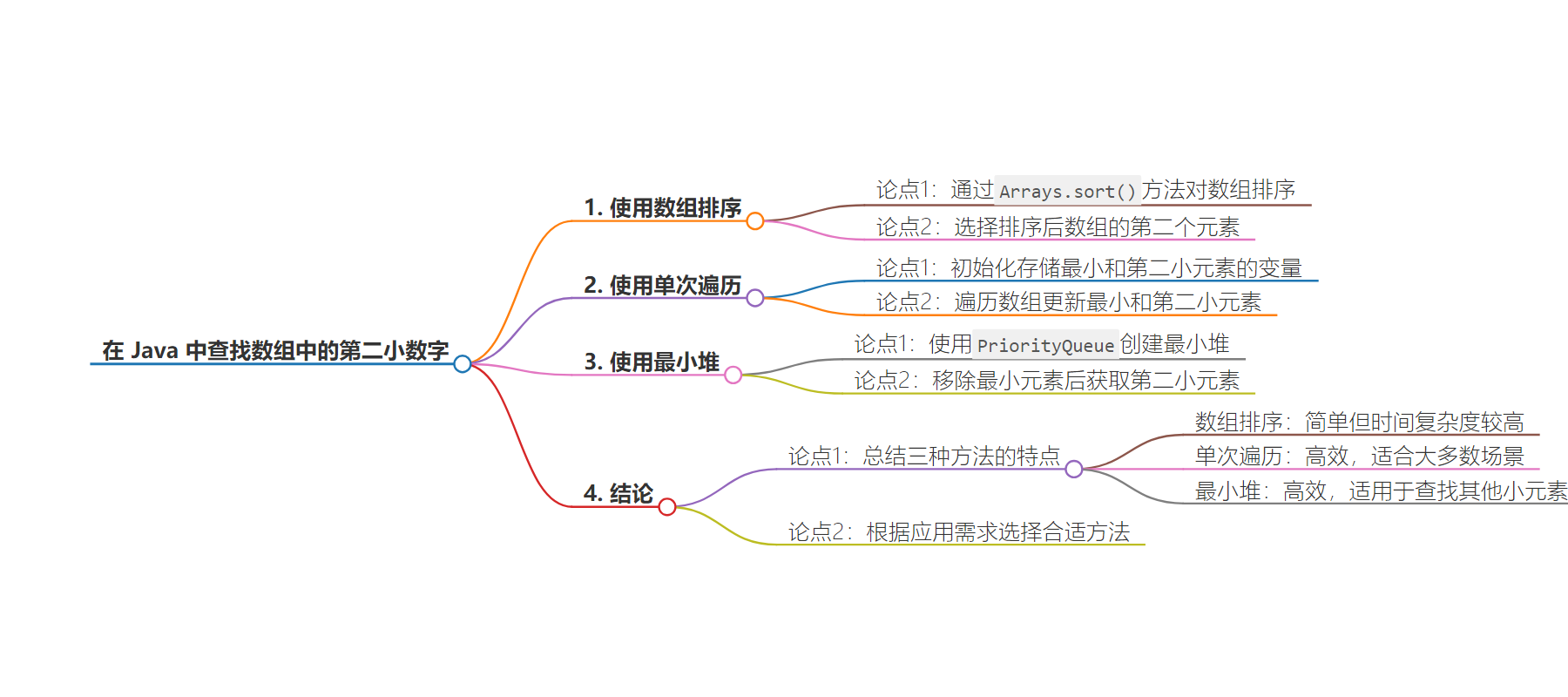包阅导读总结
1. 关键词:Java、数组、第二小元素、方法、效率
2. 总结:
本文探讨了在 Java 中寻找数组中第二小元素的三种方法,包括使用数组排序、单次遍历和最小堆。每种方法都有示例代码和输出,最后总结了各方法的特点和适用场景,用户可根据应用需求选择合适的方法。
3. 主要内容:
– 寻找数组中第二小元素的方法
– 使用数组排序
– 代码示例:先使用`Arrays.sort()`对数组排序,然后获取第二个元素。
– 输出:第二小元素为 2 。
– 使用单次遍历
– 代码示例:初始化两个变量存储最小和第二小元素,遍历数组更新变量。
– 输出:第二小元素为 2 。
– 使用最小堆
– 代码示例:将数组元素放入最小堆,移除最小元素后获取第二小元素。
– 输出:第二小元素为 2 。
– 结论
– 各方法特点和适用场景
– 数组排序:简单但效率不高,时间复杂度 O(n log n) 。
– 单次遍历:高效,时间复杂度 O(n) ,适用大多数场景。
– 最小堆:高效,时间复杂度 O(n log k) ,有助于找到其他小元素。
思维导图:
文章地址:https://www.javacodegeeks.com/finding-the-second-smallest-number-in-an-array-in-java.html
文章来源:javacodegeeks.com
作者:Yatin Batra
发布时间:2024/7/16 11:56
语言:英文
总字数:592字
预计阅读时间:3分钟
评分:84分
标签:Java,Array,Algorithms,Sorting,Min Heap
以下为原文内容
本内容来源于用户推荐转载,旨在分享知识与观点,如有侵权请联系删除 联系邮箱 media@ilingban.com
In this article, we will explore three different methods to find the second smallest number in an array using Java. These methods include:
- Using Array Sorting
- Using Single Pass Through
- Using Min Heap
1. Using Array Sorting
One of the simplest ways to find the second smallest integer in an array is by sorting the array and then selecting the second element. Here is how you can do it:
1.1 Code Example and output
package com.jcg.example; import java.util.Arrays;public class SecondSmallest { public static void main(String[] args) { int[] array = { 5, 1, 4, 2, 8 }; Arrays.sort(array); int secondSmallest = array[1]; System.out.println("The second smallest element is: " + secondSmallest); }}
The above code sorts the array using Arrays.sort() method, and then accesses the second element of the sorted array which is the second smallest integer. The code gives the following output on the IDE console:
The second smallest element is: 2
2. Using Single Pass Through
This method involves a single pass through the array to find the smallest and second smallest elements without sorting the array.
2.1 Code Example and output
package com.jcg.example;public class SecondSmallest { public static void main(String[] args) { int[] array = { 5, 1, 4, 2, 8 }; if (array.length < 2) { System.out.println("Array is too small to find the second smallest element."); return; } int first = Integer.MAX_VALUE; int second = Integer.MAX_VALUE; for (int num: array) { if (num < first) { second = first; first = num; } else if (num < second && num != first) { second = num; } } if (second == Integer.MAX_VALUE) { System.out.println("No second smallest element found."); } else { System.out.println("The second smallest element is: " + second); } }}
The code initializes two variables first and second to store the smallest and second smallest elements respectively. It then iterates through the array to update these variables based on the current element. The code gives the following output on the IDE console:
The second smallest element is: 2
3. Using Min Heap
A Min Heap can be used to efficiently find the second smallest element by extracting the two smallest elements from the heap.
3.1 Code Example and output
package com.jcg.example;import java.util.PriorityQueue;public class SecondSmallest { public static void main(String[] args) { int[] array = { 5, 1, 4, 2, 8 }; PriorityQueue minHeap = new PriorityQueue (); for (int num: array) { minHeap.offer(num); } if (minHeap.size() < 2) { System.out.println("Array is too small to find the second smallest element."); return; } minHeap.poll(); // remove the smallest element int secondSmallest = minHeap.poll(); // get the second smallest element System.out.println("The second smallest element is: " + secondSmallest); }}
The code uses a PriorityQueue (which is a Min Heap) to store the elements of the array. The smallest element is removed using poll(), and the next call to poll() retrieves the second smallest element. The code gives the following output on the IDE console:
The second smallest element is: 2
4. Conclusion
We have explored three different methods to find the second smallest integer in an array in Java. Each method has its advantages and use cases:
- Array Sorting: Simple and straightforward but not the most efficient with O(n log n) time complexity.
- Single Pass Through: Efficient with O(n) time complexity, suitable for most scenarios.
- Min Heap: Efficient with O(n log k) time complexity and useful for finding other small elements as well.
Depending on the specific requirements of your application, you can choose the method that best suits your needs.
